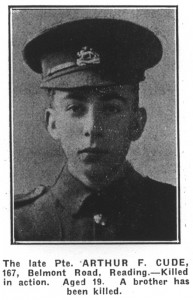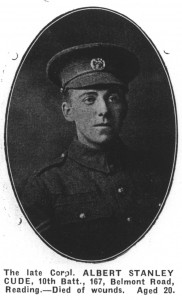Arthur Frederick Cude
Private 2929
1st/4th Battalion Royal Berkshire Regiment
Division 21
Arthur Frederick Cude was the son of Mrs. Ellen Cude, of 142, Wilson Road, Reading. He was killed in action on the 16th May1916, aged 19. It is believed that Arthur Cude lost his life in the attack set out below:
“In May, the 1st/4th’s took over “G” sector, an area of unfamiliar and difficult ground near Tourvent farm on the outskirts of Serre. The ground was badly cut up with old trenches and shell holes and littered with bones from the fighting in June 1915. The communications trench was 1½ miles long and in a very poor state. Rations had to be brought up from Hébuterne. The front line was itself a salient which projected towards the strong German defence system around Serre. The line was defended with some difficulty using an arrangement of disconnected outposts. At 12.30 a.m. on the morning of 16th May a raid took place. The Germans had opened a violent bombardment on another sector around midnight on the left of the 48th Division. The guns of the 48th division responded to a false SOS and the Germans, after registering on the division guns, then directed heavy fire at the batteries. Across a frontage of 600 yards two platoons of the 1st/4th’s manned seven detached posts. The bombardment lasted half an hour and was directed at the front and supervision lines. At 1 a.m. the bombardment shifted to the support and reserve trenches with shells falling at a rate of a hundred per minute. “B” company in their outposts were over powered and half a supporting platoon of “A” company were destroyed in the bombardment. When the Germans finally made their attack the outposts were in such disarray that they managed to get in behind and attack the Berkshires from the rear. The attack, continued by German infantry until 1.40a.m. along different parts of the salient, and the bombardment went on all night until it stopped at dawn. Losses numbered 98, 18 killed and 29 missing, later most were reported as prisoners of war. ‘B’ company lost half its fighting strength. This was the first serious test for the 1st/4th’s and their endurance, discipline and fighting spirit were praised by the Divisional and Corps Commanders”.
(From Petre Official HistoryVolume III)
Arthur Cude is buried Hebuterne Military Cemetery, Pas de Calais, France. Grave location Plot I Row C 4.
Albert Stanley Cude
Corporal 9883
10th Battalion Hampshire Regiment
Albert Stanley Cude was the son of Mrs. Ellen Cude, of 142, Wilson Road, Reading. He died of wounds on 12th August 1915, aged 20. Albert Cude is commemorated on the Helles Memorial, Turkey. Panels 125-134 or 223-226, 228-229 7 328.
The Helles Memorial stand on the tip of the Gallipoli Peninsula. It takes the form of an obelisk over 30 meters high that can be seen by shipping passing through the Dardanelles. It carries over 20,000 names of those who died during the Gallipoli campaign whose graves are unknown or who were lost or buried at sea in Gallipoli waters.
The British had successfully landed at Sulva Bay on the 6th August 1915, ready to attack with the Anzac force. In the very hot weather an attack took place the following day and further attacks took place over the following five days with very heavy losses. It is not known how Albert Cude was wounded or whether he died of wounds and his body was lost, or he was buried and his grave lost, or if he died whilst being evacuated and was buried at sea.
The brothers are commemorated on the grave of their parents in the Old Reading Cemetery. Stanley is remembered on the Blue Coat School Memorial.



![dbImage[1]](http://cemeteryjunctionwargraves.org.uk/wp-content/uploads/2013/11/dbImage1-300x225.jpg)
